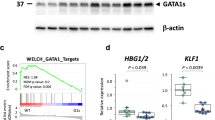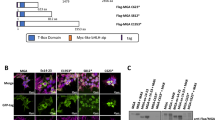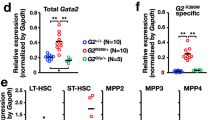Abstract
Mutations of the GATA1 gene on chromosome X have been found in almost all cases of transient myeloproliferative disorder and acute megakaryoblastic leukemia (AMKL) accompanying Down syndrome (DS). Although most GATA1 mutations lead to the expression of GATA1s lacking the N-terminal activation domain, we recently found two novel GATA1 proteins with defects in another N-terminal region. It has been suggested that loss of the N-terminal portion of GATA1 might interfere with physiological interactions with the critical megakaryocytic transcription factor RUNX1, and this would imply that GATA1s is not able to interact properly with RUNX1. However, the interaction domain of GATA1 remains controversial. In this study, we show that GATA1 binds to RUNX1 through its zinc-finger domains, and that the C-finger is indispensable for synergy with RUNX1. All of the patient-specific GATA1 mutants interacted efficiently with RUNX1 and retained their ability to act synergistically with RUNX1 on the megakaryocytic GP1bα promoter, whereas the levels of transcriptional activities were diverse among the mutants. Thus, our data indicate that physical interaction and synergy between GATA1 and RUNX1 are retained in DS-AMKL, although it is still possible that increased RUNX1 activity plays a role in the development of leukemia in DS.
This is a preview of subscription content, access via your institution
Access options
Subscribe to this journal
Receive 12 print issues and online access
$259.00 per year
only $21.58 per issue
Buy this article
- Purchase on Springer Link
- Instant access to full article PDF
Prices may be subject to local taxes which are calculated during checkout





Similar content being viewed by others
References
Lange B . The management of neoplastic disorders of haematopoiesis in children with Down's syndrome. Br J Haematol 2000; 110: 512–524.
Wechsler J, Greene M, McDevitt MA, Anastasi J, Karp JE, Le Beau MM et al. Acquired mutations in GATA1 in the megakaryoblastic leukemia of Down syndrome. Nat Genet 2002; 32: 148–152.
Mundschau G, Gurbuxani S, Gamis AS, Greene ME, Arceci RJ, Crispino JD . Mutagenesis of GATA1 is an initiating event in Down syndrome leukemogenesis. Blood 2003; 101: 4298–4300.
Hitzler JK, Cheung J, Li Y, Scherer SW, Zipursky A . GATA1 mutations in transient leukemia and acute megakaryoblastic leukemia of Down syndrome. Blood 2003; 101: 4301–4304.
Rainis L, Bercovich D, Strehl S, Teigler-Schlegel A, Stark B, Trka J et al. Mutations in exon 2 of GATA1 are early events in megakaryocytic malignancies associated with trisomy 21. Blood 2003; 102: 981–986.
Groet J, McElwaine S, Spinelli M, Rinaldi A, Burtscher I, Mulligan C et al. Acquired mutations in GATA1 in neonates with Down's syndrome with transient myeloid disorder. Lancet 2003; 361: 1617–1620.
Xu G, Nagano M, Kanezaki R, Toki T, Hayashi Y, Taketani T et al. Frequent mutations in the GATA-1 gene in the transient myeloproliferative disorder of Down's syndrome. Blood 2003; 102: 2960–2968.
Look AT . A leukemogenic twist for GATA1. Nat Genet 2002; 32: 83–84.
Speck NA, Gilliland DG . Core-binding factors in haematopoiesis and leukaemia. Nat Rev Cancer 2002; 2: 502–513.
Ichikawa M, Asai T, Saito T, Seo S, Yamazaki I, Yamagata T et al. AML-1 is required for megakaryocytic maturation and lymphocytic differentiation, but not for maintenance of hematopoietic stem cells in adult hematopoiesis. Nat Med 2004; 10: 299–304.
Song WJ, Sullivan MG, Legare RD, Hutchings S, Tan X, Kufrin D et al. Haploinsufficiency of CBFA2 causes familial thrombocytopenia with propensity to develop acute myelogenous leukaemia. Nat Genet 1999; 23: 166–175.
Elagib KE, Racke FK, Mogass M, Khetawat R, Delehanty LL, Goldfarb AN . RUNX1 and GATA-1 coexpression and cooperation in megakaryocytic differentiation. Blood 2003; 101: 4333–4341.
Yanagida M, Osato M, Yamashita N, Liqun H, Jacob B, Wu F et al. Increased dosage of Runx1/AML1 acts as a positive modulator of myeloid leukemogenesis in BXH2 mice. Oncogene 2005; 24: 4477–4485.
Hitzler JK, Zipursky A . Origins of leukaemia in children with Down syndrome. Nat Rev Cancer 2005; 5: 11–20.
Waltzer L, Ferjoux G, Bataille L, Haenlin M . Cooperation between the GATA and RUNX factors Serpent and Lozenge during Drosophila hematopoiesis. EMBO J 2003; 22: 6516–6525.
Kitabayashi I, Ida K, Morohoshi F, Yokoyama A, Mitsuhashi N, Shimizu K et al. The AML1-MTG8 leukemic fusion protein forms a complex with a novel member of the MTG8 (ETO/CDR) family, MTGR1. Mol Cell Biol 1998; 18: 846–858.
Hashimoto Y, Ware J . Identification of essential GATA and Ets binding motifs within the promoter of the platelet glycoprotein Ib alpha gene. J Biol Chem 1995; 270: 24532–24539.
Sato T, Fuse A, Eguchi M, Hayashi Y, Ryo R, Adachi M et al. Establishment of a human leukaemic cell line (CMK) with megakaryocytic characteristics from a Down's syndrome patient with acute megakaryoblastic leukaemia. Br J Haematol 1989; 72: 184–190.
Toki T, Katsuoka F, Kanezaki R, Xu G, Kurotaki H, Sun J et al. Transgenic expression of BACH1 transcription factor results in megakaryocytic impairment. Blood 2005; 105: 3100–3108.
Toki T, Arai K, Terui K, Komatsu N, Yokoyama M, Katsuoka F et al. Functional characterization of the two alternative promoters of human p45 NF-E2 gene. Exp Hematol 2000; 28: 1113–1119.
Kanezaki R, Toki T, Yokoyama M, Yomogida K, Sugiyama K, Yamamoto M et al. Transcription factor BACH1 is recruited to the nucleus by its novel alternative spliced isoform. J Biol Chem 2001; 276: 7278–7284.
Eisbacher M, Holmes ML, Newton A, Hogg PJ, Khachigian LM, Crossley M et al. Protein–protein interaction between Fli-1 and GATA-1 mediates synergistic expression of megakaryocyte-specific genes through cooperative DNA binding. Mol Cell Biol 2003; 23: 3427–3441.
Visvader JE, Crossley M, Hill J, Orkin SH, Adams JM . The C-terminal zinc finger of GATA-1 or GATA-2 is sufficient to induce megakaryocytic differentiation of an early myeloid cell line. Mol Cell Biol 1995; 15: 634–641.
Muntean AG, Crispino JD . Differential requirements for the activation domain and FOG-interaction surface of GATA-1 in megakaryocyte gene expression and development. Blood 2005; 106: 1223–1231.
Martin DI, Orkin SH . Transcriptional activation and DNA binding by the erythroid factor GF-1/NF-E1/Eryf 1. Genes Dev 1990; 4: 1886–1898.
Waltzer L, Bataille L, Peyrefitte S, Haenlin M . Two isoforms of Serpent containing either one or two GATA zinc fingers have different roles in Drosophila haematopoiesis. EMBO J 2002; 21: 5477–5486.
Trainor CD, Omichinski JG, Vandergon TL, Gronenborn AM, Clore GM, Felsenfeld G . A palindromic regulatory site within vertebrate GATA-1 promoters requires both zinc fingers of the GATA-1 DNA-binding domain for high-affinity interaction. Mol Cell Biol 1996; 16: 2238–2247.
Ferreira R, Ohneda K, Yamamoto M, Philipsen S . GATA1 function, a paradigm for transcription factors in hematopoiesis. Mol Cell Biol 2005; 25: 1215–1227.
Barrett DM, Gustafson KS, Wang J, Wang SZ, Ginder GD . A GATA factor mediates cell type-restricted induction of HLA-E gene transcription by gamma interferon. Mol Cell Biol 2004; 24: 6194–6204.
Kim WY, Sieweke M, Ogawa E, Wee HJ, Englmeier U, Graf T et al. Mutual activation of Ets-1 and AML1 DNA binding by direct interaction of their autoinhibitory domains. EMBO J 1999; 18: 1609–1620.
Deveaux S, Filipe A, Lemarchandel V, Ghysdael J, Romeo P-H, Mignotte V . Analysis of the thrombopoietin receptor (mpl) promoter implicates GATA and Ets proteins in the coregulation of megakaryocyte-specific genes. Blood 1996; 87: 4678–4685.
Deveaux S, Cohen-Kaminsky S, Shivdasani RA, Andrews NC, Filipe A, Kuzniak I et al. p45 NF-E2 regulates expression of thromboxane synthase in megakaryocytes. EMBO J 1997; 16: 5654–5661.
Zhang C, Gadue P, Scott E, Atchison M, Poncz M . Activation of the megakaryocyte-specific gene platelet basic protein (PBP) by the Ets family factor PU.1. J Biol Chem 1997; 272: 26236–26246.
Acknowledgements
This work was supported in part by Grants-in-Aid for Scientific Research, Grants-in-Aid for Scientific Research on Priority Areas from the Ministry of Education, Science, Sports and Technology, and a Grant for Priority Research Designated by the President of Hirosaki University.
Author information
Authors and Affiliations
Corresponding author
Rights and permissions
About this article
Cite this article
Xu, G., Kanezaki, R., Toki, T. et al. Physical association of the patient-specific GATA1 mutants with RUNX1 in acute megakaryoblastic leukemia accompanying Down syndrome. Leukemia 20, 1002–1008 (2006). https://doi.org/10.1038/sj.leu.2404223
Received:
Accepted:
Published:
Issue Date:
DOI: https://doi.org/10.1038/sj.leu.2404223
Keywords
This article is cited by
-
RUN(X) out of blood: emerging RUNX1 functions beyond hematopoiesis and links to Down syndrome
Human Genomics (2023)
-
Tumor cell-released kynurenine biases MEP differentiation into megakaryocytes in individuals with cancer by activating AhR–RUNX1
Nature Immunology (2023)
-
Pharmacologic targeting of the P-TEFb complex as a therapeutic strategy for chronic myeloid leukemia
Cell Communication and Signaling (2021)
-
Histone arginine methylation keeps RUNX1 target genes in an intermediate state
Oncogene (2013)
-
Transcriptional control of megakaryocyte development
Oncogene (2007)



